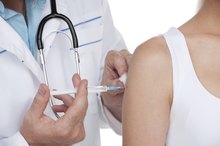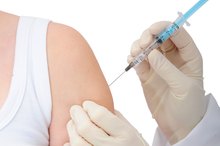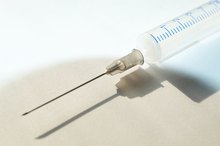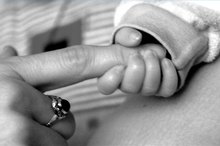Common Side Effects of the HCG Trigger Shot
HCG, or human chorionic gonadotropin, is a drug given to mature eggs from artificially stimulated ovaries during assisted reproductive technology, or ART procedures. HCG is usually given 34 to 36 hours before egg retrieval, since release usually occurs naturally 36-plus hours after administration, the University of Maryland Medical Center explains. HCG can be given as a recombinant, or laboratory-made drug, or in an injection derived from the urine of pregnant women. HCG in either form can have side effects.
If you are experiencing serious medical symptoms, seek emergency treatment immediately.
Common Side Effects
Some side effects of HCG are mild and common. While these symptoms are usually short-lived, worsening symptoms should be reported to your doctor, as they could be early signs of ovarian hyperstimulation syndrome 1. Soreness at the injection site may occur; redness or swelling should be reported to your doctor.
Allergic Reactions
Symptoms of Pregnancy If HCG Injection Is Taken
Learn More
As with any drug, allergic reactions can occur to the proteins in HCG. These include rashes, hives, swelling, shortness of breath, lightheadness or collapse. Report any potential signs of allergy to your doctor immediately.
Ovarian Hyperstimulation
The most serious side effect of HCG when given to induce egg release in fertility procedures is the development of ovarian hyperstimulation syndrome, or OHSS 1. Ovarian hyperstimulation occurs when large number of follicles are matured after HCG is given. Some fertility clinics will not give HCG in an ART cycle if the estradiol level is over a certain number, to prevent OHSS from developing. Others will not transfer embryos if OHSS is present, because pregnancy will drive hormone levels even higher.
Side effects of mild OHSS include mild swelling, abdominal discomfort and weight gain. Fluid may accumulate in the lungs, making breathing difficult. Nausea, vomiting and diarrhea may deplete already dry blood volume. OHSS can be fatal in rare cases, the U.S. National Library of Medicine states.
- The most serious side effect of HCG when given to induce egg release in fertility procedures is the development of ovarian hyperstimulation syndrome, or OHSS 1.
- Some fertility clinics will not give HCG in an ART cycle if the estradiol level is over a certain number, to prevent OHSS from developing.
Related Articles
References
- Medline Plus: U.S. Library of Medicine; Ovarian Hyperstimulation Syndrome
- Khademi A, Alleyassin A, Aghahosseini M, Tabatabaeefar L, Amini M. The Effect of Exercise in PCOS Women Who Exercise Regularly. Asian Journal of Sports Medicine. 2010;1(1). doi:10.5812/asjsm.34874.
- Bates GW, Legro RS. Longterm management of Polycystic Ovarian Syndrome (PCOS). Molecular and Cellular Endocrinology. 2013;373(1-2):91-97. doi:10.1016/j.mce.2012.10.029.
- Pericleous P, Stephanides S. Can resistance training improve the symptoms of polycystic ovary syndrome? BMJ Open Sport & Exercise Medicine. 2018;4(1). doi:10.1136/bmjsem-2018-000372
- Cabry-Goubet R, Scheffler F, Belhadri-Mansouri N, et al. Effect of Gonadotropin Types and Indications on Homologous Intrauterine Insemination Success: A Study from 1251 Cycles and a Review of the Literature. BioMed Research International. 2017;2017:1-12. doi:10.1155/2017/3512784.
- Doumouchtsis SK, Arulkumaran S, Ojha K. Ovarian hyperstimulation syndrome. Oxford Medicine Online. 2016. doi:10.1093/med/9780199651382.003.0014
- Ding D-C, Huang C, Hong M-K. A review of ovary torsion. Tzu Chi Medical Journal. 2017;29(3):143. doi:10.4103/tcmj.tcmj_55_17
- Legro RS, Arslanian SA, Ehrmann DA, et al. Diagnosis and Treatment of Polycystic Ovary Syndrome: An Endocrine Society Clinical Practice Guideline. The Journal of Clinical Endocrinology & Metabolism. 2013;98(12):4565-4592. doi:10.1210/jc.2013-2350
- Mahajan N, Gupta S, Sharma S, Rani K, Naidu P, Arora P. Early onset ovarian hyperstimulation syndrome despite use of segmentation approach and ovarian hyperstimulation syndrome prophylaxis. Journal of Human Reproductive Sciences. 2015;8(4):234. doi:10.4103/0974-1208.170415
- Cozzolino M, Troiano G, Esencan E. Bed rest after an embryo transfer: a systematic review and meta-analysis. Archives of Gynecology and Obstetrics. 2019;300(5):1121-1130. doi:10.1007/s00404-019-05296-5
Writer Bio
A registered nurse with more than 25 years of experience in oncology, labor/delivery, neonatal intensive care, infertility and ophthalmology, Sharon Perkins has also coauthored and edited numerous health books for the Wiley "Dummies" series. Perkins also has extensive experience working in home health with medically fragile pediatric patients.









